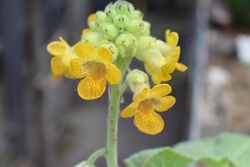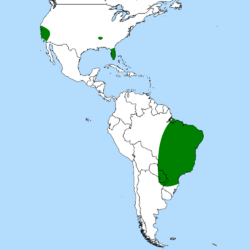Biology:Ibicella lutea
| Ibicella lutea | |
|---|---|

| |
| Flowers | |
| Scientific classification | |
| Kingdom: | Plantae |
| Clade: | Tracheophytes |
| Clade: | Angiosperms |
| Clade: | Eudicots |
| Clade: | Asterids |
| Order: | Lamiales |
| Family: | Martyniaceae |
| Genus: | Ibicella |
| Species: | I. lutea
|
| Binomial name | |
| Ibicella lutea (Lindl.) Van Eselt.
| |

| |
| Ibicella lutea distribution | |
| Synonyms | |
| |
Ibicella lutea (/aɪbɪˈsɛlə ˈljuːtiə/; syn. Martynia lutea, Proboscidea lutea) is a species of flowering plant known by the common name yellow unicorn-plant.[1] It grows in dry conditions, such as those in desert regions. It is native to South America, but has become established as a non-native species in various semi-arid regions around the world, including Southern Africa and the Central Valley of California. The plant is aromatic, with an unpleasant scent. It produces short, glandular hairs over most of its aerial surfaces and is coated in sticky resin. Insects often become stuck in the slimy exudate and die, but the plant does not have digestive enzymes and does not absorb nutrients from the insects.[citation needed] The plant can be considered protocarnivorous, but it is not carnivorous.
References
- ↑ "Ibicella lutea". Natural Resources Conservation Service PLANTS Database. USDA. https://plants.usda.gov/core/profile?symbol=IBLU. Retrieved 16 August 2017.
Wikidata ☰ Q139166 entry
 |

